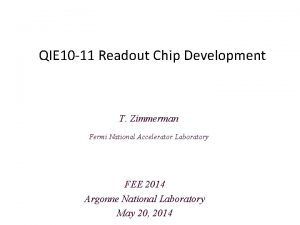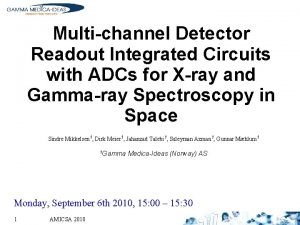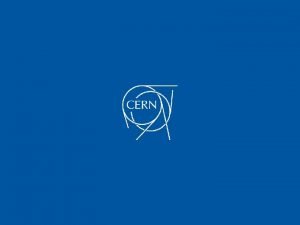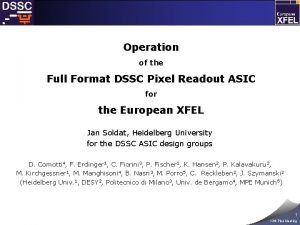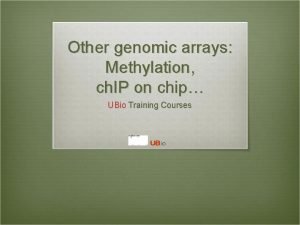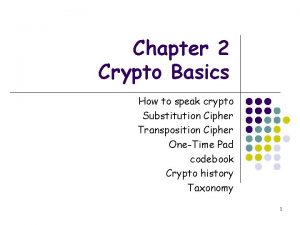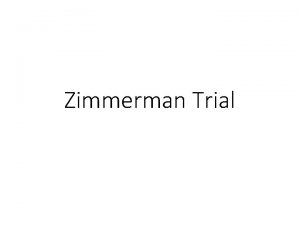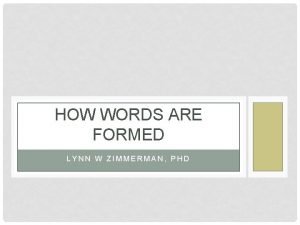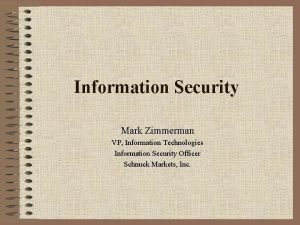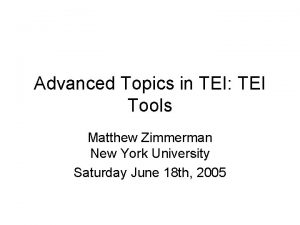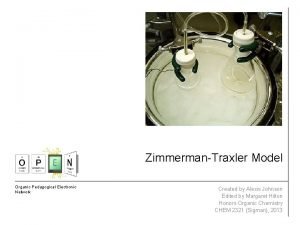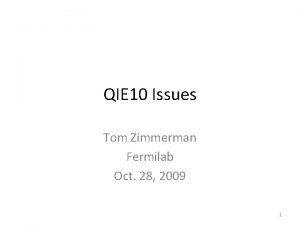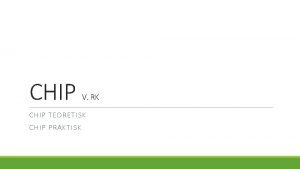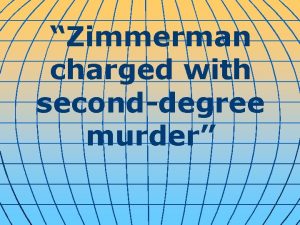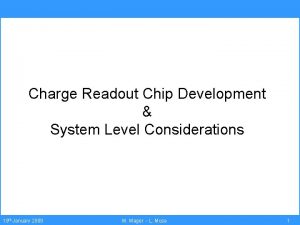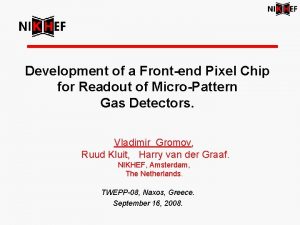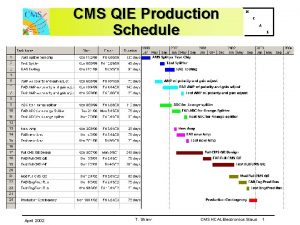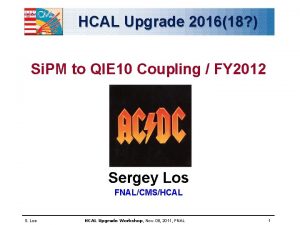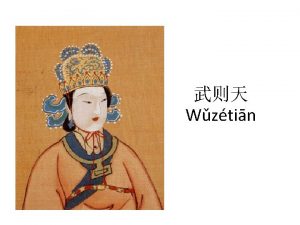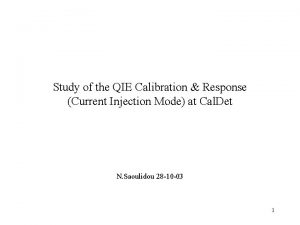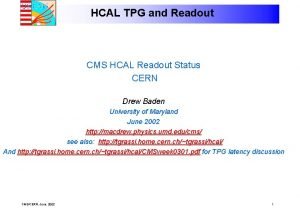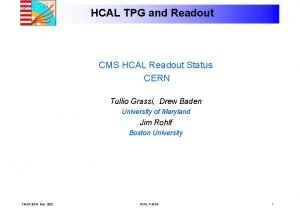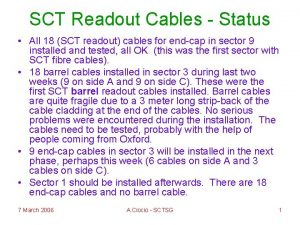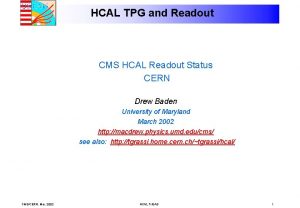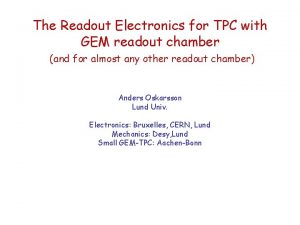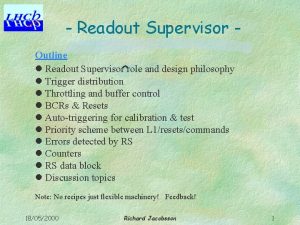QIE 10 11 Readout Chip Development T Zimmerman

![Overview of multi-decade QIE development • • The QIE [Charge (Q) Integrator and Encoder] Overview of multi-decade QIE development • • The QIE [Charge (Q) Integrator and Encoder]](https://slidetodoc.com/presentation_image_h/9314f730c7ba8b1c6769cf7941761933/image-2.jpg)




















- Slides: 22

QIE 10 -11 Readout Chip Development T. Zimmerman Fermi National Accelerator Laboratory FEE 2014 Argonne National Laboratory May 20, 2014
![Overview of multidecade QIE development The QIE Charge Q Integrator and Encoder Overview of multi-decade QIE development • • The QIE [Charge (Q) Integrator and Encoder]](https://slidetodoc.com/presentation_image_h/9314f730c7ba8b1c6769cf7941761933/image-2.jpg)
Overview of multi-decade QIE development • • The QIE [Charge (Q) Integrator and Encoder] is a custom ASIC designed to digitize wide dynamic range charge signals from photo-detectors (PMTs, Si. PMs), with approximately constant resolution and no deadtime A short history: – 1989: Originally conceived by Bill Foster for SDC @ SSC – 1995: 1 st fully-functional chip designed by Tom Zimmerman for the KTe. V experiment @ FNAL (QIE 5) • 2 mm Orbit “Bi-CMOS”, 3000 ch. – 1996: Front-end for calorimeters of CDF @ FNAL (QIE 6) • 2 mm Orbit “Bi-CMOS”, 10, 000 ch. – 2002: Front-end for MINOS Near Detector @ FNAL (QIE 7) • 2 mm Orbit “Bi-CMOS”, 10, 000 ch. – 2003: Front-end for CMS HCAL @ CERN (QIE 8) • 0. 8 mm AMS Bi. CMOS, 10, 000 ch. . – 2004: Front-end for BTEV @ FNAL (cancelled) (QIE 9) • 0. 8 mm AMS Bi. CMOS – 2013 -14: Front-end for CMS forward calorimeter (QIE 10) Barrel and endcap calorimeters (QIE 11) • 0. 35 mm AMS Si. Ge Bi. CMOS 2

All QIE chips are based on the NPN bipolar current splitter concept: To multi-range integrator inputs Input current The current split ratios are determined by NPN emitter area ratios (using multiples of a unit transistor). Split ratios remain constant over a big dynamic range, even in the presence of mismatch (not true for MOS)! Therefore, all QIE chips are realized using a Bi. CMOS process.

Overview of QIE 10 • The newest design (QIE 10) features: – Dead-timeless operation @ 40 MHz, using 4 -phase operation (same as all previous QIEs) – High dynamic range: 3 f. C – 330 p. C (~17 bits). 6 -bit mantissa, 4 Ranges 256 codes (10 X the range of QIE 8) – Logarithmic response - ~1% measurement across dynamic range – Controlled impedance input over full dynamic range (5 meter input cable from PMT) – 6 bit TDC (0. 5 ns) with programmable threshold (first QIE with a TDC) – Serial download of programmable parameters (new feature) – True LVDS outputs – On-chip test charge injection – Low power: 320 m. W • +5 V @ 40 m. A analog • +3. 3 V @ 35 m. A digital – 350 nm AMS Si. Ge process (first QIE to use this process) 4

Overview of QIE 11 • Similar to QIE 10 with the following differences: – Intended for Si. PM readout – Programmable input current shunt to achieve scaling factors of: x 1, x 1. 5, x 2, x 3, x 4, x 6, x 8, x 12 (in order to accommodate higher than anticipated Si. PM gain) – Lowest possible input impedance (not constant, impedance naturally goes down as signal magnitude goes up) 5

• How the QIE 10 works: ¬ Receives charge (current) from PMT Anode ¬ “Splits” current into four weighted Ranges ¬ Gates and integrates current fractions onto separate capacitors ¬ Based on the signal magnitude, 1 of the 4 Ranges is selected to be digitized • Ranges are logarithmically weighted (X 8) ¬ Digitizes the analog voltage from the selected Range • 6 -bit FADC with logarithmic response (bin width 1, 2, 4, 8) “Mantissa” ¬ Outputs 2 -bit code for the Range digitized (0 - 3) “Exponent” ð Produces floating-point output codes ð Response is approximately logarithmic… V I PMT I Current Splitter 1, 8, 64, 512 Range Select Gated Integrator 1, 2, 4, 8 V 2 Bits Range TDC 6 Bits log FADC 6 bits Mantissa 2 bits Delay Exponent 6 bits TDC 6 Data Out 14 Bits

In reality, 4 sets of integrators (4 phases A-D) are used to achieve dead-timeless operation: – Operations are pipelined at 40 MHz using 4 -phase circuits – Data includes 2 -bit Cap. ID to indicate phase Clock & Phase Control 40 MHz Integrate Reset integrator Integrate and hold Range select Digitize Gated Integrator Circuit A I Gated Integrator Circuit B I I PMT I Current Splitter Range Select Reset I 4 pipelined phases: • • ð Produces a code representing the current integrated in each and every 25 ns period and never stops Gated Integrator Circuit C Gated Integrator Circuit D V V Digitize Cap. ID 2 Bits Cap. ID Out 2 Bits Range Select Circuit A Range Select Circuit B Range Select Circuit C V Range Select Circuit D ADC FADC 2 Bits Delay 6 Bits Range 2 Bits 7

• Splitter/integrator implementation: – – – 24 identical NPN transistors, arranged in groups: x 16, x 4, x 2, x 1 Integrator capacitor ratios: 1, 2, 8, 32 Results in 4 integration ranges, each scaled by X 8 Selected integrator feeds a 4 -section ADC with binary weighted bin widths Results in effectively 16 ranges, scaled by x 2 Simplified diagram: • Only 1 of 4 integration phases shown • Shown as single-ended implementation, actually done in pseudo-differential form (shown later) 8

The combination of x 8 range scaling and a 4 -section piecewise-linear ADC give “ 16 -range” floating-point response: Range 0 Range 1 Range 2 Range 3 9

Controlled impedance input amplifier/splitter design challenges • • • Constant split ratio over wide dynamic range: NPN splitter required (not NMOS) Small DC input bias current (< 20 u. A) Constant impedance input for 0 – 60 m. A input current: requires novel feedback amp approach Basic approach: I Current splitter R C 1 Q 1 C Both gm 1 and gm 3 go up with ISIG: M 2 RIN remains constant! IDC Small signal analysis C 1 C ISIG IDC VDC CEXTERNAL M 2 Feedback amp Stabilize the open-loop gain: replace R with I source and Q 3 Q 1 10 u. F REXTERNAL ISIG RIN = 20 ohms But ISIG >> IDC so NOT small signal! Arrange the value of C 1 so the pole cancels the zero: resistive input to very high frequency! gm 1 goes up with ISIG, so open-loop gain and RIN changes with ISIG! For the biggest signals (>> 1 m. A), M 2 is debiased, and Q 1 functions as an open-loop common base amp, with input resistance set by REXTERNAL. Tune VDC and REXTERNAL for RIN = 20 ohms. 10

A crucial QIE strategy: Implement all analog circuits in pseudo-differential form: 2 “identical” inputs -- signal source connects to the SIG input, and the REF input floats RESULT: excellent stability and common-mode rejection (relatively immune to shifts in bias levels, supply voltage, clock frequency, temperature, etc. ) Pseudo-differential Flash ADC SIG REF V V EXPONENT Range Select and MUX V 4 -range, 4 -phase REF integrators I Current Splitter External noise PMT 50 ohm coax SIGNAL INPUT MANTISSA V 4 -range, 4 -phase REF integrators I Current Splitter REFERENCE INPUT For the best external pickup rejection, use 2 identical input cables! Identical cables in close proximity Pickup is mostly common mode, therefore rejected! 11

Pseudo-differential TDC implementation Convert current pulse to voltage Iin/24 From SIG splitter 50 -to-6 encode 6 -bit TDC code Discriminator Latch Set threshold 25 ns clock 0 1 2 49 0. 5 ns delay elements Delay Locked Loop delay control voltage From REF splitter Phase comparator 12

Pseudo-differential Flash ADC implementation Voltage buffers SIG and REF resistor ladders Averaging ladder improves DNL and allows interpolation Larger bin widths: averaging ladder not required! 4 different bin widths Constant current develops voltage drops across SIG ladder 13

Another crucial QIE strategy: Create isolated substrate areas on the same chip. Reference them all to the die pad (“system ground”). This greatly reduces digital-to-analog coupling! Package die pad (functions as system ground) Chip Digital substrate/ground ADC substrate/ground Digital circuits Deep Nwell isolation (collector) Splitters Analog substrate/ground 14

Put it all together: QIE 10 full chip block diagram 6 ADC Cap. ID CImode Charge Inject SRreset PMT Serial Program Register (64 bits) SRout (CMOS output) REF (1/24)I TDC Timing Amp DLL REF Discrim. SIG REF 4 -phase Integrator Cint = 32 Input amp/current splitter Shadow Register (SEU-hard) SRload SRread SRin SRck SIG 4 -phase Integrator Cint = 8 (2/24)I SIG (inject) (4/24)I (16/24)I REF SIG Discrim. threshold Programmable FE bias SIG Phase Control REF (40 MHz) Range Select/Mux Cap. ID pedestals CMOS inputs Discrim (LVDS output) Discrim. threshold 4 -phase Integrator Cint = 2 2 Mantissa Vref Vsig SIG 6 Exponent REF 2 4 -phase Integrator Cint = 1 SLVS/ Ck LVDS Reset inputs Synchronizer LVDS outputs (80 MHz) TDC Out 0 Out 1 Out 2 Out 3 Out 4 Out 5 Out 6 Out 7 (1/24)I No. Lock (CMOS output) Ck (40 MHz) DLLrst (CMOS input)

QIE 10 Test Results • • • LSB = 3 f. C (as expected) Input impedance stable over complete dynamic range Noise with 5 meter RG 58 input cables: 1. 8 f. C (input referred) Noise with short (0. 2 meter) RC 58 input cables: 0. 6 f. C No change in pedestals or noise after 50 KRad TID (Cs-137 source) No SEUs in shadow register holding programmed values after 6 E 12 p/cm 2 (230 Me. V proton beam) 16

Measured QIE 10 input resistance over full dynamic range (DAC provided for tweaking of input resistance at low end) 17

Study ADC response on a single range: ð Response as expected – See all 4 ADC sections Look at uniformity across all 4 cap. IDs (phases) (one ADC section shown): ð Response as expected ð Note: Uses cap. ID pedestal adjust feature to make pedestals uniform 18

Study of bin widths in the 4 -section ADC: ð See nice uniform bin widths ð Bin width variation minimized in bottom 2 sections by design (small bin size requires less variation than large bin to achieve the same DNL) 19

• Timing Studies - TDC Response – Apply external input pulse (well above TDC threshold). – Step pulse delay by 50 ps, average 100 data points per setting Entries = 48 AVG= 0. 500 RMS= 0. 082 1 Overflow Data from Fermilab ð See nice linear response ð Bin width uniformity is good: average width = 0. 50 ns, DNL < 0. 1 ns 20

QIE 11 (Si. PM readout chip) • • Non-inverting input (same as QIE 10) Current shunt provides programmable gain to accommodate big Si. PM signals Low input impedance for big signals (remove constant impedance circuit) Full-chip prototype works well (x 5 shunt) with only a couple of small bugs Current splitter Input resistance ~15 ohms for small signal, no shunt Input resistance ~1 ohm for largest signal, big shunt Programmable shunt Signal current 21

QIE: a success story over 25 years! Future QIE work this year: • • Modification of QIE 11 for ATLAS: add another bit of resolution (7 -bit mantissa) Quad QIE (4 per package)? ? 22
 Zimmerman
Zimmerman Readout integrated circuit
Readout integrated circuit Qie es adhd
Qie es adhd Readout units
Readout units Readout device
Readout device Full pixel readout
Full pixel readout Por.qu
Por.qu Methylation & chip-on-chip microarray platform
Methylation & chip-on-chip microarray platform Kaylan szafranski
Kaylan szafranski Zimmerman telegram simple definition
Zimmerman telegram simple definition Was zimmerman convicted
Was zimmerman convicted Robert zimmerman imperial
Robert zimmerman imperial Zimmerman telegram
Zimmerman telegram Lynn zimmerman attorney
Lynn zimmerman attorney Piotr zimmerman
Piotr zimmerman Shirley zimmerman functions of the family
Shirley zimmerman functions of the family Zimmerman telegram political cartoon
Zimmerman telegram political cartoon 14 points compared to the treaty of versailles
14 points compared to the treaty of versailles Powder keg wwi
Powder keg wwi Digital engineering
Digital engineering Eric zimmerman tools
Eric zimmerman tools Keene and zimmerman 1997
Keene and zimmerman 1997 Zimmerman-traxler transition state
Zimmerman-traxler transition state
